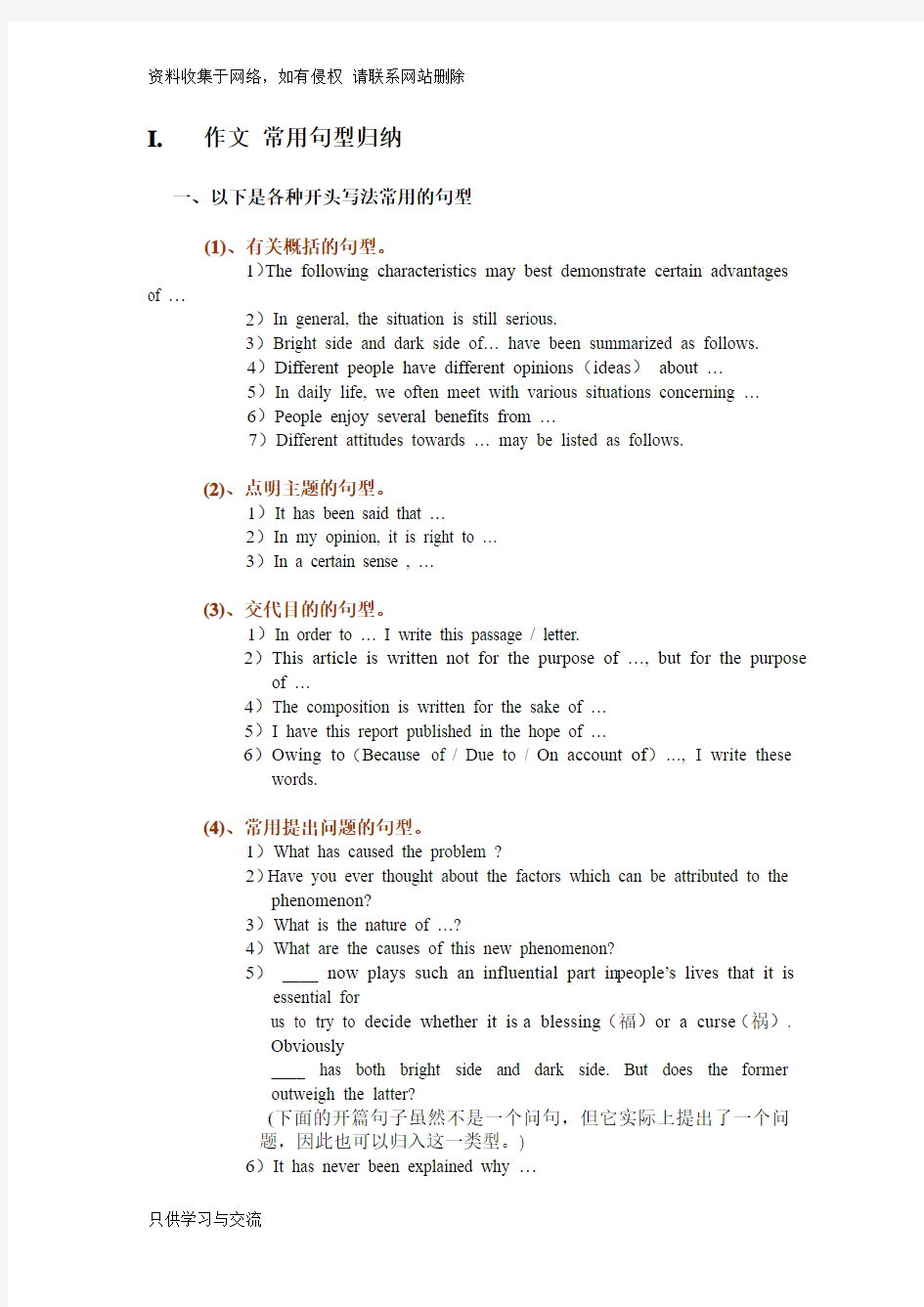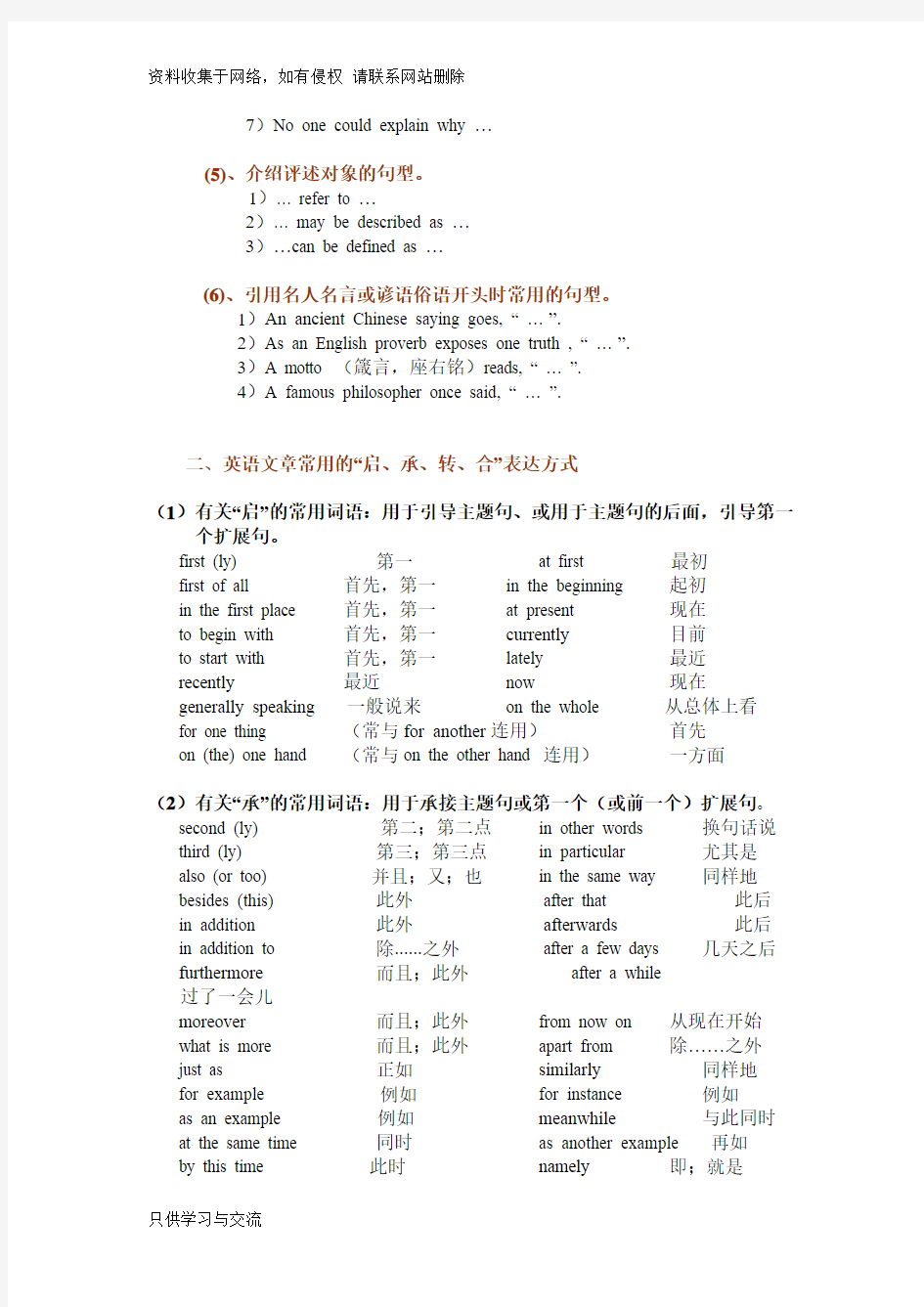作文 常用句型归纳


I.作文常用句型归纳
一、以下是各种开头写法常用的句型
(1)、有关概括的句型。
1)The following characteristics may best demonstrate certain advantages of …
2)In general, the situation is still serious.
3)Bright side and dark side of… have been summarized as follows.
4)Different people have different opinions(ideas)about …
5)In daily life, we often meet with various situations concerning …
6)People enjoy several benefits from …
7)Different attitudes towards … may be listed as follows.
(2)、点明主题的句型。
1)It has been said that …
2)In my opini on, it is right to …
3)In a certain sense , …
(3)、交代目的的句型。
1)In order to … I write this passage / letter.
2)This article is written not for the purpose of …, but for the purpose of …
4)The composition is written for the sake of …
5)I have this report publ ished in the hope of …
6)Owing to(Because of / Due to / On account of)…, I write these words.
(4)、常用提出问题的句型。
1)What has caused the problem ?
2)Have you ever thought about the factors which can be attributed to the phenomenon?
3)What is the nature of …?
4)What are the causes of this new phenomenon?
5)____ now plays such an influential part in people’s lives that it is essential for
us to try to decide whether it is a blessing(福)or a curse(祸).
Obviously
____ has both bright side and dark side. But does the former
outweigh the latter?
(下面的开篇句子虽然不是一个问句,但它实际上提出了一个问
题,因此也可以归入这一类型。)
6)It has never been explained why …
7)No one could explain why …
(5)、介绍评述对象的句型。
1)… refer to …
2)… may be described as …
3)…can be defined as …
(6)、引用名人名言或谚语俗语开头时常用的句型。
1)An ancie nt Chinese saying goes, “ …”.
2)As an English proverb exposes one truth , “ …”.
3)A motto (箴言,座右铭)reads, “ … ”.
4)A famous philosopher once said, “ … ”.
二、英语文章常用的“启、承、转、合”表达方式
(1)有关“启”的常用词语:用于引导主题句、或用于主题句的后面,引导第一个扩展句。
first (ly) 第一at first 最初
first of all 首先,第一in the beginning 起初
in the first place 首先,第一at present 现在
to begin with 首先,第一currently 目前
to start with 首先,第一lately 最近
recently 最近now 现在
generally speaking 一般说来on the whole 从总体上看
for one thing (常与for another连用)首先
on (the) one hand (常与on the other hand 连用)一方面
(2)有关“承”的常用词语:用于承接主题句或第一个(或前一个)扩展句。
second (ly) 第二;第二点in other words 换句话说third (ly) 第三;第三点in particular 尤其是
also (or too) 并且;又;也in the same way 同样地
besides (this) 此外after that 此后in addition 此外afterwards 此后in addition to 除......之外after a few days 几天之后furthermore 而且;此外after a while
过了一会儿
moreover 而且;此外from now on 从现在开始what is more 而且;此外apart from 除……之外just as 正如similarly 同样地
for example 例如for instance 例如
as an example 例如meanwhile 与此同时at the same time 同时as another example 再如
by this time 此时namely 即;就是
soon 不久then 然后
of course 当然for this purpose 为此equally important 同样重要another example is … 再如for another (前句有for one thing)其次
a case in point is 适当的例子是to illustrate 比如
an illustration of this 例如for another 其次still another 再如for another example 再如
(3)有关“转”的常用词语:用来表示不同或相反的情况。
after all 毕竟on the contrary 相反地
but 但是in contrast 相比之下yet 仍然;然而unlike… 与……不同however 然而whereas… 然而……
on the other hand 另一方面nevertheless 尽管如此nonetheless 尽管如此all the same 但是conversely 相反unfortunately 不幸地though 尽管如此still 仍然although 虽然in fact 事实上despite or in spite of 尽管as a matter of fact 事实上by comparison 比较而言by contrast 对比而言in reality 实际上
(4)有关“合”的常用词语:用于小结段落中上文的内容、引导最后一个扩展句或引导结
尾句表示段落的结束。
finally 最后as has been noted 如前所述hence 因此as I have said 如我所述in brief 简言之at last 终于in conclusion 总之at length 最后;终于for that reason 正因为如此in consequence
结果
in short 简而言之by and large 一般说来in summary 概括地说consequently 因此therefore 因此eventually 最终thus 因此accordingly 于是to sum up 总而言之indeed 的确to conclude 总而言之surely 无疑to summarize 总而言之no doubt 毫无疑问briefly 简单地说undoubtedly 无疑above all 最重要的是truly 的确as a consequence 因此so 所以as a result 结果obviously 显然for this reason 正因为如此certainly 无疑in a word 一言以敝之in sum 总而言
之
as the above examples show 如上述例子所示
in the final analysis 分析归结到一点
[注] (1)上面所列各种“启、承、转、合”表达方式只是一个基本分类。在不同的上、下文中,有的表达方式如:naturally, obviously, consequently等
可以表达多种逻辑关系。在具体的上下文中究竟哪一个为最佳表达方
式仍需进一步甄选。
(2)并不是任何一个段落都有一个完整的“启、承、转、合”的过程。一般说来,“启、承”比较固定,而“转、合”则往往要取决于文体和段落的
发展方法。
三、结尾部分可能使用的结束语
(1)、意犹未尽。此类结束语往往能唤起读者的期待感。
1)The suggestion(proposal, plan, scheme, etc.)is open to question (discussion,
argument etc.).
2)The phenomenon remains to be further studied.
3)This article is only the beginning of a long essay.
4)What has been discussed above is only the tip of an iceberg (冰山一角).
5)The story is hardly unique, there are many similar stories in reality.
6)This is not the only case. It is worth conducting further research.
7)But this new application is another story—one we will talk about in another article.
(2)、号召呼吁。作者往往在此类结束语中提出一些具体建议。
1)It’s time for us to realize the urgency of the situation. Complaint and gloom are useless, we should readjust to new challenges. Today we must
take immediate actions to preserve a hopeful tomorrow.
2)Though we have made much progress, we must remember that it is only the first step in the right direction. Let’s continue to contribute our efforts
and ideas. To solve the problem(To reach our goals, To realize our
dreams ,To carry out the project further etc.), we still have a long way to
go.
3)To realize this vision, we should initiate(开始,着手)a series of measures. Firstly, government must enforce strategic policy in the long
run. Secondly, the development of ___ has to come along with the
perfecting of the country’s laws(or democracy or social security
network, etc.). Thirdly, the power to implement laws(执法力度)should
be strengthened. All this means that we must take immediate and
efficient actions.
4)Ways of coping with the issue are many, but what really counts is that we should do more than talk about handling the problem. Only when the
